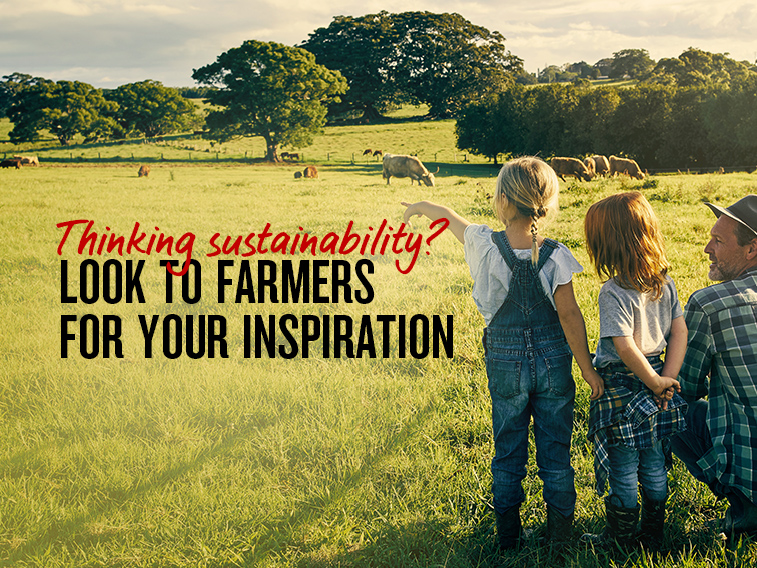The latest NAB Regional & Agribusiness webinar provides insights on the Australian & Global Economies, and a regional and rural property update. Watch the webinar here.


How sustainable farming methods are helping Australian farmers maintain the value of their natural assets over the long term.

Australia’s farmers are a living example of sustainability leading to better business and environmental outcomes, writes NAB Agribusiness Customer Executive Neil Findlay.
The word ‘sustainable’ is invoked frequently in the commercial world but, here in Australia, our farmers don’t just talk the talk – across the country, they’re walking the walk.
One of the most rewarding aspects of my role at NAB is the opportunity it affords to meet our customers and see their dedication to implementing more efficient and sustainable farming methods. Long-term planning and prudent management of natural capital and assets are second nature to those running Australia’s 85,000-plus farm businesses and the rural enterprises that service them.
Although the country no longer rides on the sheep’s back, primary production remains one of Australia’s largest and steadiest export industries, despite changing economic conditions and a variable climate. While the number of corporate farms has grown in recent years, farming is still very much a family affair in this country. For many individuals working the land, the concept that responsible stewardship leads to better results has been passed down through generations.
Weather-related events remain the top issue affecting confidence in the sector, according to the NAB Agribusiness Banker Survey Q1, 2019; hardly a surprise in the land of drought and flooding rain. Other recent bank research has found that soil health and energy costs are also regarded by farmers as significant business risks. Our customers are solutions-oriented people and three quarters of respondents indicated they were taking steps to address these issues.
As I’ve travelled through our farming communities I’ve been lucky enough to witness many innovative sustainable technologies and practices firsthand. Here are five important ways farmers are managing their resources to nurture their continuing health.
Whether they’re involved in broadacre cropping or viticulture, those on the land don’t need to be reminded water is a precious resource.
Weather and water allocations determine, respectively, how much water they need and how much they’re able to access. We see customers investing significant sums in soil monitoring and variable rate irrigation systems to make sure every drop is used wisely. Digital technology has made it possible to monitor what’s going on below the surface remotely and to track parameters such as soil moisture content, salinity and temperature with a great deal of accuracy. Reduced inputs and improved yields are often the results and they’re ones we’re delighted to help our customers achieve.
Safeguarding the soil
The Australian droughts of the twentieth and twenty-first centuries have long served as cautionary tales about the worst-case scenario that drought, wind erosion and poor soil conservation practices can create.
In 2019 Australia, farmers are minimising tilling of the soil to ensure they don’t allow their lands to become similarly degraded. We see machinery and equipment that enables crops to be sown using direct drilling techniques finding favour on broadacre cropping properties across Australia. These low-disturbance methods can maintain the moisture in soil and make it less prone to erosion; a positive for farmers looking to preserve the productivity of their croplands.
Biodiversity
Investing in native vegetation allows farmers to protect their waterways and soils from erosion and provide shade and shelter from extreme weather for their stock. Few city folk realise that the pollinators that support most crop production spend much of the year living in native vegetation.
Diverse native vegetation can also support predatory insects that, through integrated pest management (IPM) programs, enable farmers to reduce their use of pesticides. Some farmers are investing in native vegetation for on-farm benefits while others are harnessing co-funding from carbon and other environmental markets. To date, the Federal Government’s Emissions Reduction Fund has purchased 125.7 million tonnes of carbon from vegetation at an average price of $12 per tonne.
Precise pasture management
Overgrazing is the antithesis of sustainable livestock production and every bit as damaging to the land as over-ploughing. In addition to reducing the productivity of pastoral lands, it can encourage the spread of invasive weeds and speed up the desertification process.
Pasture management systems can involve considerable capital expenditure, in the form of additional fences and electric fencing units. These can prove an excellent investment for graziers looking to manage the grazing and regrowing process more sustainably by rotating their livestock among a greater number of paddocks.
Renewable energy
Sunshine is one natural resource we’re not short of in Australia.
In common with their city cousins, we see farmers around the country embracing the renewable energy trend by investing in solar panels to power their enterprises more cleanly and greenly into the future and, in some instances, generate off-farm income by supplying the grid with green power. Here, we are seeing payback periods of around four years or even less depending on scale, how favourable conditions are (roof access etc) and what the energy is being used for, for example replacing diesel pumps. Other renewable energy sources include the use of farm waste to generate electricity, while a growing number of farmers are benefitting from the financial flexibility that siting wind turbines on their properties brings.
How NAB is supporting sustainability over the long term
NAB was an early supporter of Australian agriculture and we remain deeply committed to backing a sector that’s key to our country’s prosperity and growth.
The bank has a history that spans three centuries of partnering with farmers and agribusiness owners to fund capital works, equipment and technology that contribute to productivity and sustainability. Our agri-banking team works with customers to evaluate the business case for the capital works and equipment they wish to invest in and identify the most appropriate funding vehicle. For projects such as fencing, earthworks and soil rejuvenation, we might offer traditional loan facilities, such as a Business Markets Loan. Major plant and equipment and IT solutions are commonly acquired using asset finance.
We regard ourselves as more than bankers. We frequently bring farmers together, face to face and electronically, to share information and experiences about sustainable farming initiatives. Our customers are capable, solutions-oriented and collaborative. Being welcomed into their community as trusted advisers is an honour we don’t take for granted.
As they continue to explore innovative ways to cultivate crops and husband livestock more sustainably, we’ll continue to make the journey with them, providing the funding and support they need to progress and prosper.
Safeguarding all of our futures
While all these activities are good for farming, there is increasing recognition that what happens on farms has broader societal impacts than just the provision of a supply of healthy food. By looking after their soil, water and biodiversity, farmers are delivering benefits to downstream communities, in the form of cleaner water, a cleaner climate and more. They really are stewards of the land.
© National Australia Bank Limited. ABN 12 004 044 937 AFSL and Australian Credit Licence 230686.